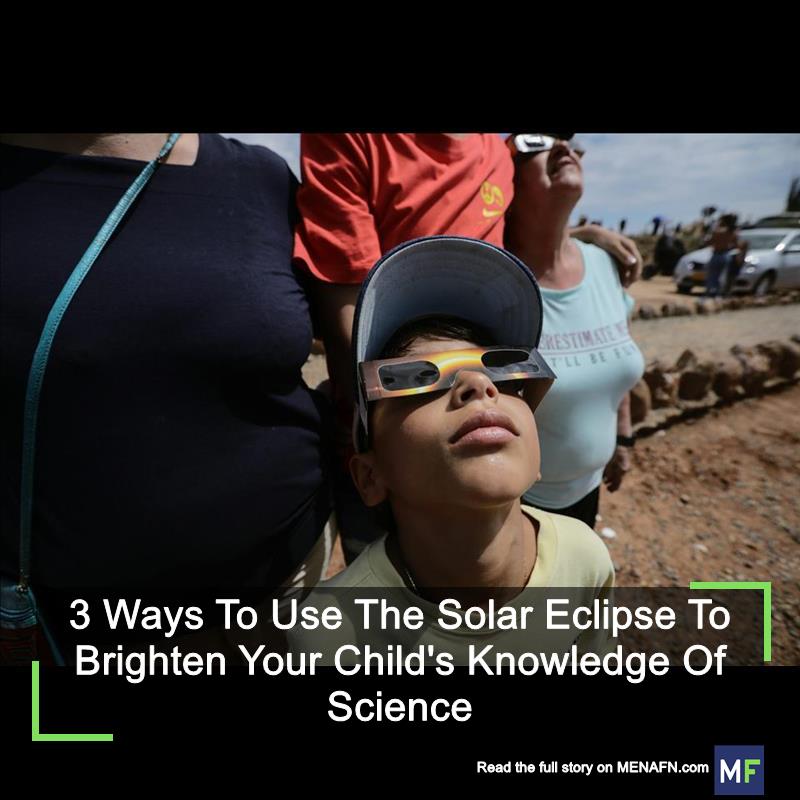
3 Ways To Use The Solar Eclipse To Brighten Your Child's Knowledge Of Science
As STEM researchers at Purdue's Center for Early Learning , we suggest three ways to make the total solar eclipse a fun experience for young children and teach some important science along the way.
1. Discuss historical versus modern understandings of eclipsesIt is important that children learn to consider and contrast multiple ideas when developing explanations for why something happens. One way to do this is to compare historical and modern explanations for why solar eclipses occur.
Share with the kids that, historically, many people across cultures feared eclipses. Some thought they signified disapproval from the gods . Others believed they predicted bad tidings to come, including shipwrecks and storms .
Contrast those explanations with easy-to-understand scientific explanations of today. Britannica Kids offers a great resource for children under 8 . Scientific American has a webpage that works well for older kids .
When contrasting scientific evidence with historical beliefs, it is important not to be critical of other cultures. Use the eclipse to talk about how scientific knowledge is built over time through observation. There are many things we do not know now that we will learn 10, 20 or even 100 years from now.
2. Have conversations using scientific languageTeaching children about the solar eclipse isn't just about explaining the what and the why. It's also about engaging in rich dialogue. Our prior research shows that young children's science knowledge is highly based on language . Both parents and teachers play a role in shaping this language.
Use science-related vocabulary to enrich children's understanding of the eclipse. Examples include: orbit, rotate, spin, reemerge, Sun, Moon, Earth, far, distance, total and partial.
Children understand science concepts more deeply and use more complex vocabulary when adults use inquiry-based strategies. For example, adults can ask children what they see happening while watching the eclipse and why they think that is. Then the adults can ask the children to make predictions about what else could happen and provide evidence for their explanations.
Children can document their observations throughout the eclipse in their own science journals using both science-related vocabulary and drawings of what they see. The journals are a great opportunity to discuss their ideas and have rich conversations.
3. Use household items to help children understand the eclipseThree-dimensional models allow children to visualize things that are otherwise difficult to see, such as the orbit of the Earth and the Moon. Comparisons between the model and their observations of real life, especially when guided by a teacher or parent, help children build knowledge about complex topics in science.
During the solar eclipse, the Moon moves directly between the Earth and the Sun. In small groups at school or at home, one child can represent the Earth, while another holds a basketball to represent the Sun and another a tennis ball to represent the Moon.
Children can model the eclipse with household items like soccer balls and tennis balls.
The child representing the Earth can orbit the Sun and rotate in place, experimenting with changing their distance from the Sun and Moon. Closing one eye, the child may eventually see the basketball completely blocked by the tennis ball when it aligns just right. This is what happens in a total solar eclipse.
In this exercise, children are not only modeling the eclipse but also building scientific vocabulary. Throughout the activity, parents and teachers can ask children to compare and contrast the model to their own observations. They can ask questions, such as why do the Sun and Moon look like they are similar sizes in the sky, even though we know that the Sun is many times larger than the Moon? If the Moon is smaller, how does it block the Sun completely? The key is to help children generate hypotheses, test their ideas and then develop new conclusions.
We hope these ideas will encourage everyone to take advantage of this wonderful scientific learning experience. We also warn you not to look directly into the Sun during the eclipse and to get the right eclipse glasses . Looking directly at the Sun, even through sunglasses or cameras, can cause severe injury to the eyes .

Legal Disclaimer:
MENAFN provides the
information “as is” without warranty of any kind. We do not accept
any responsibility or liability for the accuracy, content, images,
videos, licenses, completeness, legality, or reliability of the information
contained in this article. If you have any complaints or copyright
issues related to this article, kindly contact the provider above.
















Comments
No comment